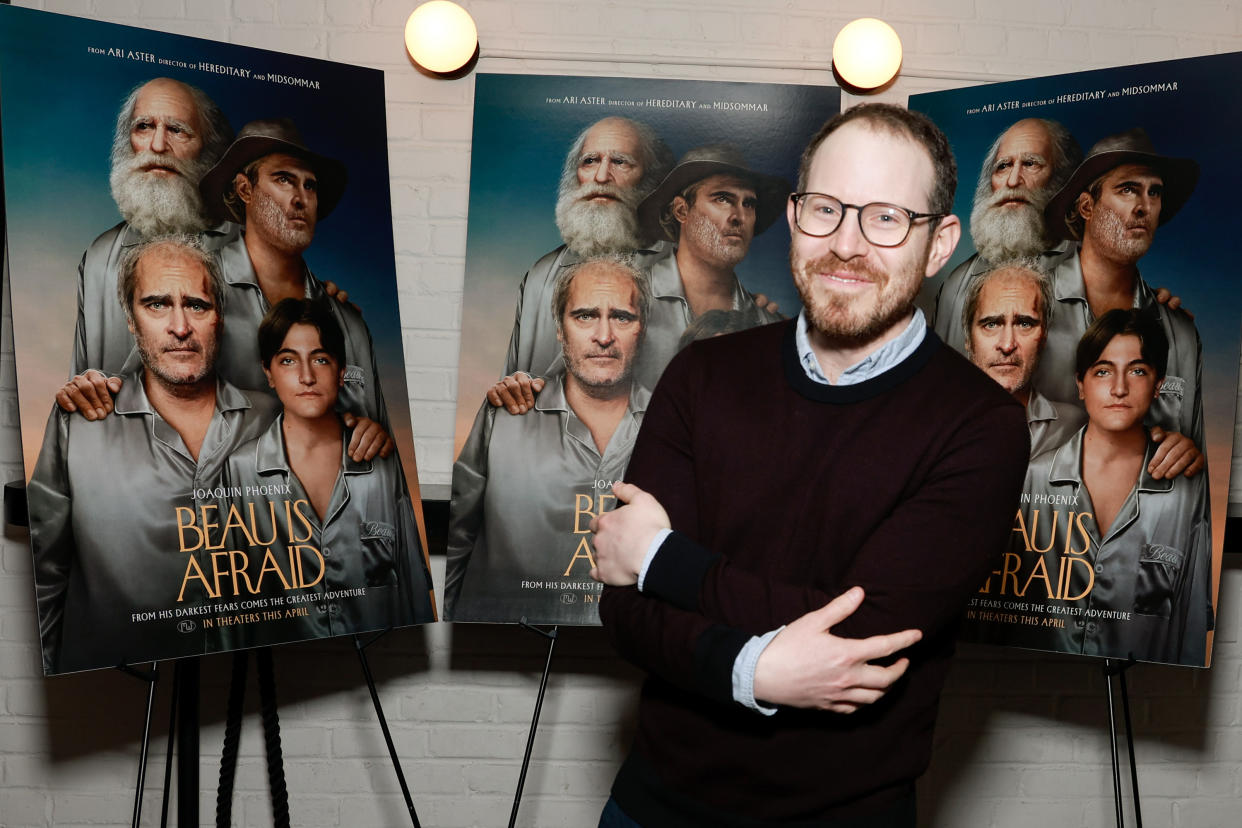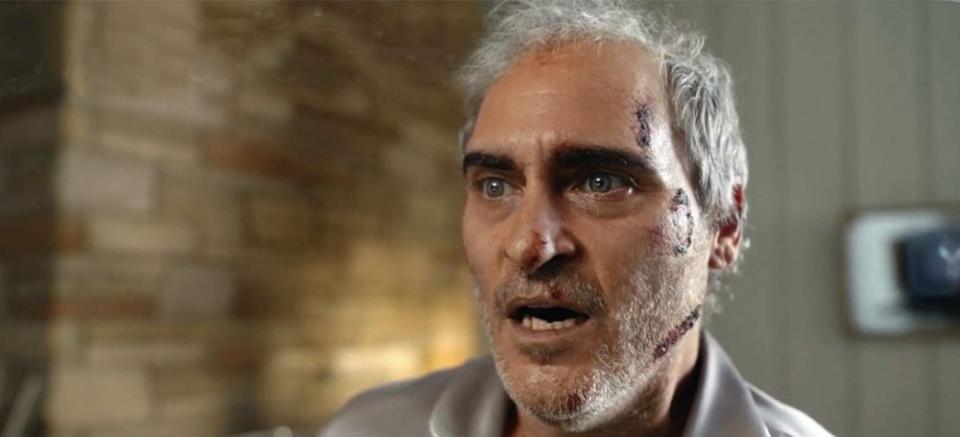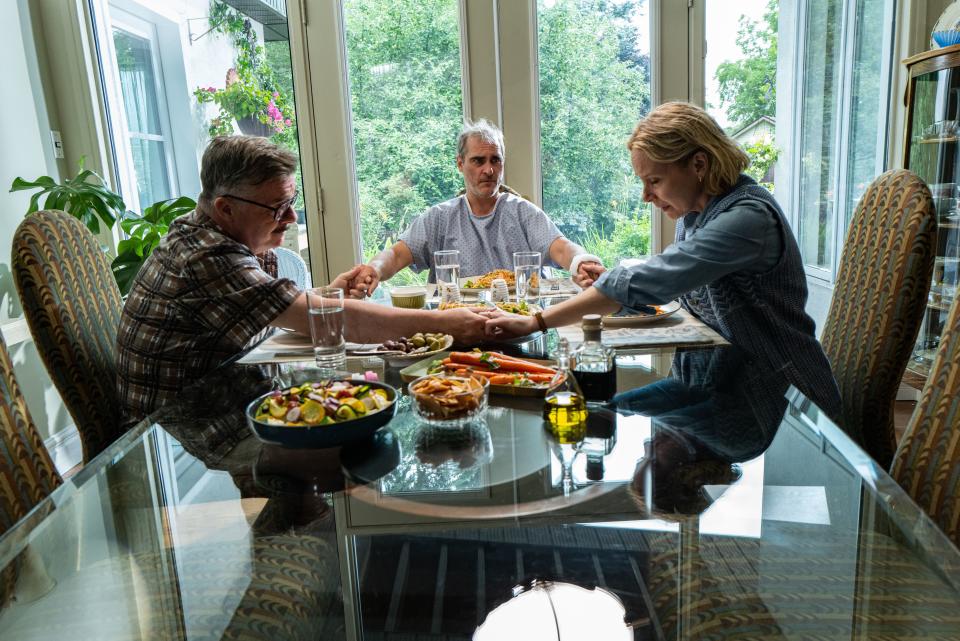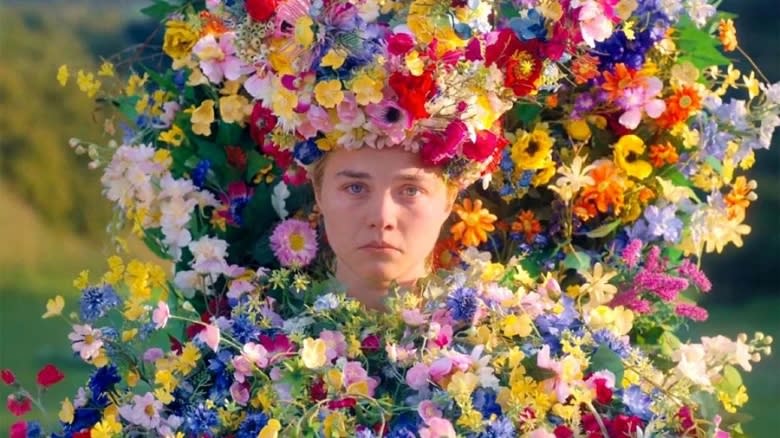Ari Aster’s Guide to ‘Beau Is Afraid’: The Director Explains His Wildest Movie Yet

- Oops!Something went wrong.Please try again later.
- Oops!Something went wrong.Please try again later.
[Editor’s note: This story contains major spoilers for “Beau Is Afraid.”]
Ari Aster’s “Beau Is Afraid” has a lot going on: It’s a sprawling, Homeric journey into the troubled psyche of neurotic, middle-aged man (Joaquin Phoenix) and a disturbing, pitch-black comedy about Jewish guilt rooted in that man’s unresolved problems with his mother (alternately played by Zoe Lister-Jones and Patti LuPone), a woman who may or may not be dead. It’s also a claustrophobic dose of surrealist satire of urban life and consumer society, a world overmedicated and undernourished. It has a sprawling dream sequence steeped in profound emotional yearning and a monster that suggests a Phallic interpretation of Jabba the Hutt.
More from IndieWire
It’s ridiculous, tragic, silly, and absolutely unlike anything else you’ll see this year. All of which makes Aster squirm over the prospects of talking about it.
“I’ve already said way too much here,” the 36-year-old New Yorker said about a half hour into a conversation with IndieWire at the Cherry Lane Theater in the West Village. Aster had spent the last few hours at the space, which “Beau” distributor A24 acquired earlier this year, and still looked like he was having a hard time talking things through. In that regard, he was well-paired with Phoenix, as the actor notorious for evading any discussion of his process sat in an adjacent space doing interviews of his own. The smell of his chain-smoking lingered in the air and wafted into Aster’s room. “We discovered early on that we were very similar and worked in a very similar way,” Aster said. “It’s hard to talk about.”
The movie, however, invites much discussion — and Aster has been doing his part to explain what he can. Budgeted at $35 million, “Beau Is Afraid” is the most expensive feature film for A24 in its 11-year history, a feat likely made possible by the way Aster’s rising career has contributed to the company’s success. Aster’s horror debut “Hereditary” grossed $82 million on a reported $10 million budget (though Aster insists it cost closer to $5 million); his Swedish cult epic “Midsommar” made $48 million on a $10 million budget, cemented Florence Pugh as a major star, and inspired a whole new hobby for adoring teens who cosplay as the May Queen.
With “Beau,” Aster said the added resources still felt like just barely enough to pull off a movie that included a massive green screen sequence, a giant puppet, animation, and loads of other ambitious demands. “It was the same amount of stretching because what we were going for was so much larger,” he said.
Like Beau himself, of course, Aster tends to focus more on the negative side of his fame. “My personality is that if somebody likes me I tend to lose respect for them, but if they have an issue with me, I start to take them seriously,” he said. “It’s not healthy. It’s all just neuroses.”
But that’s a natural starting point for parsing the many puzzling aspects of a movie that rewards audiences willing to engage with its labyrinthine design and many provocative turns. Here are some of the key aspects of “Beau” worth singling out — ideally, after you’ve seen the movie — with input from Aster.
[One more warning: This story contains major spoilers for “Beau Is Afraid.”]
What Is This Place?

A24
The most jarring aspect of “Beau Is Afraid” early on is that it takes place in an entirely fictional world. Beau heads home from his therapist to wander a street that looks like a post-apocalyptic variation on “The Warriors,” with unruly, violent characters barreling through the grimy block around Beau’s cramped apartment and eager to break in. In an early version of the script that made the rounds back in 2014, before Aster’s directorial debut, he described the scene as “basically Skid Row.”
In reality, “Beau Is Afraid” was shot on sets in Montreal. Aster populated an entire block with fake advertisements, made-up newspapers, and vulgar graffiti (some of which he drew himself). The environment made it possible for him to create an immersive world dense with colorful and eccentric figures who surround Beau and contribute to the sense of menace that surround him at every turn.
While movies like Martin Scorsese’s Kafkaesque “After Hours” may come to mind, Aster said that he was aiming more about Jacques Tati’s “Playtime,” where the intricate mise-en-scene contributes to unexpected slapstick. “Especially in the first section of the film, I was thinking about Tati,” he said. “I wanted every background actor to be as important as what’s happening in the foreground, and really was put the time into creating not just a world with the buildings and advertisements and posters, but also making sure that these people also belonged to this world. I was just getting lost in the creation of a tapestry.”
Aster kept several Google Docs with small details he wanted to throw into the world, much of which didn’t make it into the movie. “If the name of a band or a product made me laugh, I would write it down,” he said. “This Google Doc had every stupid name I could think up. There were a few different bibles, for product names, world-populating ideas. It was nice to have too much.” The approach ensured that even if Beau’s journey was weird, it maintained the internal logic of a fictional space. “Cartoonists call it ‘chicken fat,'” Aster said. “For me, when you’re engaging with something that dense with detail, where the artist has put that much attention into really building something out, I think as a viewer you feel respected — and so you give your respect to that thing. That’s the philosophy behind it.”
Why Is Beau So Afraid?

A24
Poor Beau is haunted by his mother’s judgment early on, then grieves her while stumbling through a series of encounters with strange and unusual characters who reflect various aspects of his anxiety. The terrible yet cartoonish circumstances of her death — a chandelier falling on her head, or so he’s told — epitomize the Job-like nature of his struggles. Without saying as much, Beau feels as if the world is out to get him in the worst way possible.
His therapist (Stephen McKinley Henderson) prescribes Beau a fictional drug called Zypnotycril, but the potential side effects of taking it without water only lead to greater existential dread. Aster positions medication as an ailment rather than relief throughout the movie, as Beau later encounters a pill-popping teenager whose parents kidnap him.
The filmmaker said he has avoided prescription drugs to address his own anxieties. “I’m afraid of medication,” he said. “I’d probably be helped by it. It probably comes from the times I’ve had to take antibiotics and had a panic attack about whether I’m having side effects or not. I don’t do much of anything lightly. Things can go wrong. Everything can go wrong.”
That’s the essence of Phoenix’s hyperbolic performance, which Aster let the actor take as far as he could. Beau lives in constant fear of terrible things happening to him, in part because nothing ever good ever has. That abstract concept is constantly manifested on the actor’s face, informing its exaggerated nature at every turn.
In one critical sequence, Beau stumbles out of his childhood home with a stiff jaw, and his teeth poking out in an almost cartoonish display of devastation. “The reference for that was Kabuki,” Aster said. “In the script, it just says he’s walking away in a daze and then Joaquin bumped on that because he was like, ‘Don’t we always see people walking in a daze?'”
Does Beau Get Kidnapped or Not?
The movie arrives at its first big twist when Beau gets hit by a truck outside his home. He wakes up with an ankle bracelet under the care of a strange couple (Nathan Lane and Amy Ryan) who grieve the son they lost at the war. At the same time, they contend with a rebellious teenage daughter (Kylie Rogers) who resents Beau’s presence and ultimately blackmails him into smoking dope with her. The sense of darkness encroaching on suburban domesticity plays like an homage to Austrian auteur Michael Haneke, and when Beau discovers that he can view his entire life on the family’s TV (even fast-forwarding to the end), it seems like a nod to Haneke’s famous provocation “Funny Games” where a pair of house-invading criminals actually rewind a scene to ensure they get away with it. Eventually, Beau darts out of the home after the daughter kills herself and her mother thinks he did it. While there are a lot of ways to read these circumstances, the passage as a whole forces Beau to realize that even the most idyllic notion of American family life holds dark and destructive possibilities. Nowhere is safe.
What’s Up with All the Oedipal Stuff?
Beau’s biggest fear revolves around his relationship with his mother, who guilted him from youth about his role in killing his father (she claims he died when Beau was conceived). This contributes to Beau’s sense of alienation and the lack of intimacy in his life as the dream of a happy family continues to elude him. Late in the movie, he even dreams of a whole lifetime passing him by as he raises three boys and reunites with them as an old man. But his mother’s guilt trips make that goal and many others impossible.
“The scene is a man kind of being hypnotized and entering a play,” Aster said of the 20-minute interlude, which includes a colorful blend of sets and animation by Chilean filmmakers Cristobal Leon and Joaquin Cosiña. “He enters a world that’s all flat and very artificial sets that are revolving around him,” Aster said. It’s an otherworldly vision because nothing in Beau’s actual existence allows for it.
Beau harbors a disturbing Oedipal complex that extends to his fixation on Elaine (Parker Posey), a woman he falls for as a child who he encounters again as an adult in his mother’s home. “His mother owns Elaine,” Posey told The Hollywood Reporter at the movie’s premiere. Beau’s entire sexuality has been repressed by his mother’s tight grip on his entire existence.
If you’ve seen “Hereditary” or Aster’s unsettling incest short “There’s Something Strange About the Johnsons,” you might sense a disturbing pattern here. Aster says his parents don’t give him too much grief about any implications with respect to his own family life. “I’m lucky that there’s a lot of support on that side,” he said. “They know what I’m working on. They’re excited to see them. They’re always the first in line.”
What’s the Significance of Mariah Carey’s “Always Be My Baby”?
Late in the movie, Beau finally gets laid. It’s the only moment in the movie where Aster allows his protagonist to feel some measure of catharsis, though it doesn’t last long. Beau’s big bedroom moment has a funny-sad quality informed in part by the use of Mariah Carey’s 1995 hit “Always Be My Baby” playing over the soundtrack. Beau, of course, has remained his mother’s baby throughout his troubled adulthood and seems forever tethered to her judgmental gaze — so much so that after his partner climaxes, she freezes, and mommy dearest is standing at the door ready to scold him.
The implications of “Always Be My Baby” struck Aster as so critical to the scene that he put the song in there even before getting the rights. “I knew I wanted it from very early on. It turned out it was impossible to replace,” he said. “I tried to find something that would be cheaper. But I just knew that song and the idea of it playing during that scene made me laugh.” He ended up writing a letter to Carey asking for her permission (though the fee wasn’t waived). He finally met her at the L.A. premiere for the movie this week.
Why Does the Ending Take Place in a Stadium?
“Beau” climaxes with its leading man put on trial for mistreating his mother as he sits on a boat in front of a crowded stadium. It doesn’t take a hard look to see some resemblance to a movie theater. The implication, as Aster explains, is that we’ve been judging Aster just as much as his mother the whole time. “Hopefully, it feels in some ways like a mirror,” Aster said. As we derive pleasure from this poor man’s pain, Aster can’t help but take a stab at his audience’s complicity in the same narrative gambit he has undertaken himself.
Yes, It’s Supposed to Be Funny
From the Tati references to the climactic monster at the end, the appeal “Beau” turns on the gamble that even scary or tragic circumstances can have an inherent comedic appeal. “I hope it’s funny,” he said. When Beau encounters a literal manifestation of his repression toward the end of the movie, “it’s very stupid,” Aster said. “The task is, ‘Can we do something this stupid and have it be on any level engrossing?’ I don’t know. But that was the hope.”
Don’t Expect a Director’s Cut

In 2019, Aster unleashed a 171-minute director’s cut of “Midsommer” that added nearly half of an hour worth of material to the movie. “Beau,” which clocks in at just under three hours, isn’t on track for a similar reveal. “I’m very happy with this cut,” Aster said, insisting he wouldn’t deliver another one. His initial edit landed at three hours and 27 minutes, and he snipped away from there to land at the final length. “There are points where I resisted cutting it further, but I’m very happy with where it landed. There was a period where I definitely wanted it to be longer. But I’m happy now.”
Aster Knows You Might Not Like It
“Beau Is Afraid” takes the kind of adventurous big swings that few American movies will even attempt these days as they risk alienating large swaths of audiences. Aster knows he might have this effect on people and has been bracing for it. “If anything, I’m very aware of the backlash, people who never want to hear my name again,” he said. “It’s the nature of the internet right now makes it a weird time to create work. The reactions are so immediate, so superficial in so many ways. I’ll have periods where I do engage and it’s always such a bad idea because it gets into my head. A huge part of making new work is about doing my best to divorce myself from that and not have it affect my thinking.”
At the same time, he beams with pride over accomplishing a singular work that has been sitting in his brain for a very long time. “I don’t know what people will think of it, but it’s the film I’m proudest of making,” he said.
An A24 release, “Beau Is Afraid” opens in New York and LA on Friday, April 14 followed by theaters everywhere on Friday, April 21.
Best of IndieWire
New Movies: Release Calendar for April 14, Plus Where to Watch the Latest Films
From 'Nymphomaniac' to 'Little Ashes': Unsimulated Sex Scenes in 40 Films
Quentin Tarantino's Favorite Movies: 51 Films the Director Wants You to See
Sign up for Indiewire's Newsletter. For the latest news, follow us on Facebook, Twitter, and Instagram.

